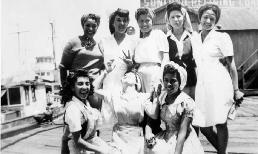Compensation & the Cannery Workers' Union
IN 1934, WAGES WERE .35 PER HOUR.
In 1935, Van Camp cannery worker, Andrea Gomez had spearheaded the
successful effort for a Terminal Island Cannery Workers' Union. By
1941, after a series of contracted wage increase, women were making .65
per hour. At the outset of the war, a night shift offered .20 more per
hour.
IN 1950, WOMEN WERE PAID BETWEEN $1.50 and $1.70
while men were paid $1.65 to $2.05 and by mid-decade the Cannery
Workers Union had settled health benefit packages and pension plans.
HEAR Mary Oreb remember how her wages helped her family.
|
 |
| Mexican-American cannery workers take a break on the wharf at Fish Harbor, c. 1947. (CLICK IMAGE FOR MORE) ~ Los Angeles Public Library/Shades of L.A. |
|
|
Union Leadership & Andrea Gomez
UNION ORGANIZING WAS A CENTRAL ISSUE FOR ANDREA URIBE GOMEZ. After her husband was injured while working for the Los Angeles Harbor Department, the young parents of six children needed a secure source of income. Andrea Gomez went to work at Van Camps cannery in 1924 at age 24. By 1933 Gomez was a seasoned worker. At that time, she recognized systematic unfair business practices.
|
National Industrial Recovery Act
BACKED BY THE NATIONAL INDUSTRIAL RECOVERY ACT that guaranteed laborers a right to collective bargaining, Andrea Gomez led the way to union membership. By 1935, cannery workers contracted the first wage agreement as the Cannery Workers Union, an affiliate of the AFL - the American Federation of Labor. The union still represents cannery- and other industrial workers as the United Industrial Workers, an AFL-CIO union.
For more information about Andrea Gomez and cannery union activity, see the comprehensive thesis, Recollections of Andrea Gomez: Terminal Island Fish Cannery Worker and Union Organizer, 1924-1965 by Ann M. Peterson, CSU Long Beach, CA, 2005.
Proquest link: http://gradworks.umi.com/14/29/1429199.html
|
|
|